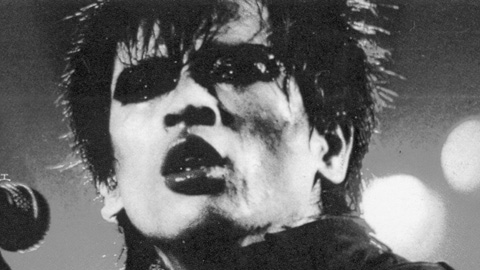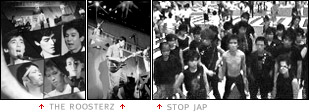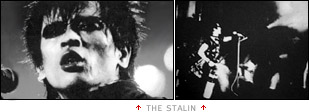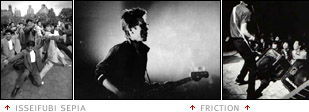The Concert Films of Sogo Ishii
- published
- 24 July 2001

Sogo Ishii was born in the right place at the right time. The man who is often referred to as Japan's punk filmmaker grew up in Hakata on the island of Kyushu. When he was in his teens, he found himself in the middle of the punk rock revolution when northern Kyushu became one of the country's most fertile breeding grounds for new bands.
Along with the Kansai area (Osaka, Kyoto, Nagoya) and inevitably Tokyo, Kyushu spawned the musicians and bands that would go on to dominate the punk scene in the late 1970s and early 80s. The first Kyushu band to rear their spiked heads were Son House, a mid-70s outfit whose gritty pre-punk rock would become a major influence on those that followed: The Roosters, fronted by the enigmatic Shinya Ohe, Takanori Jinnai's leather-clad The Rockers and the recently reformed ARB headed by Ryo Ishibashi (now one of Japan's most versatile actors, known to many for his role as the victimized widower in Takashi MiikeTakashi Miike's Audition).
Ishii himself dabbled in music as a singer and guitarist, but soon found his true vocation after moving to Tokyo in 1977 to study at Nihon University.There, 19-year old Sogo Ishii (then still known by his real name of Toshihiro Ishii) turned to film. His early shorts, shot on 8 mm and 16 mm equipment borrowed from the university, inevitably carried Ishii's affinity with the punk scene on their sleeves, featuring the struggles of misfits and underdogs against established society. Even the simple fact that Ishii made these films, that he became a film director by simply grabbing any equipment available and shooting, was an act of punk-spirited rebellion, echoing the counter-professionalist do-it-yourself attitude of the movement. This was all the more true for an aspiring Japanese filmmaker, since the traditional way to becoming a director was to get a job as an assistant and climb your way up the ranks. Ishii didn't want to be an assistant. He wanted to make films.
He would make his first full-length film a mere year after first picking up a movie camera: Panic High School (Koko Dai Panikku, 1978), a feature-length remake of his first short. He was still a student. For his graduation piece two years later he upped the ante a bit further and delivered his second feature, the manic biker movie Crazy Thunder Road (Kuruizaki Sanda Rodo, 1980). Shot on 16 mm, the film had raw energy to spare, achieved largely through the director's lightning-fast use of camera and editing, and made such a big impression that major studio Toei bought it, blew it up to 35 mm and released it in theatres. Fresh out of university, Sogo Ishii had arrived and people sat up to take notice of this uncompromising new talent. (In a Sight and Sound survey among leading international filmmakers, Takeshi Kitano named Crazy Thunder Road one of his ten favourite films of the 20th century.)

Among those people was the Tokyo-based punk band Anarchy, who asked the young director to shoot a promotional video. Employing his trusted 16 mm format, the 10-minute Anarchy '80 Isshin (1981) brought Ishii back to his punk roots, but rather than coming full circle it kickstarted a new wave of creativity. He followed it up with the 30-minute fiction film Shuffle, based on the manga Run by Akira creator Katsuhiro Otomo, before embarking on his most ambitious project yet. Burst City (Bakuretsu Toshi, 1982) would become the apotheosis of Ishii's punk cinema, combining the deranged bikers motif of his previous feature with a cast consisting of famous faces from Japan's punk scene, many of whom took leading roles in addition to performing in the film. For the shooting, bands and musicians from the country's three punk capitols united in the countryside outside Tokyo: The Roosters and The Rockers represented Kyushu, Machizo Machida of the band Inu hailed from Kansai, while Michiro Endo's The Stalin served as the Tokyo delegates.
The Stalin's involvement was particularly significant. They had become the country's leading punk exponents, the Japanese equivalent of the Sex Pistols, and their appearance in Burst City led to Ishii directing the video for their next single, entitled Stop Jap. Despite their popularity, the band would decide to call it quits two years later. Their 1984 farewell tour spawned a final live album plus a concert video, once again directed by Ishii: The Stalin For Never. Dark, ominous and intensely powerful, The Stalin For Never captures the boundless energy and soul of the band's live performances, spearheaded by the charismatic yet enigmatic Endo. The singer, his pale, wiry body clad in black, radiated energy, and Ishii wisely decided to focus the attention on him. Though off-stage he is reportedly a quiet end even shy man, the Michiro Endo of Ishii's film is a natural performer, a man born to be on stage.

The film starts with an empty stage and arena (a shot that also ends the film), followed by grainy close-ups (Ishii again shot in 16 mm) of the four musicians superimposed over shots of a restless audience. Surprisingly, the concert starts with two slow but atmospheric songs that are closer to gothic new wave than punk, including the band's magnum opus Mushi. But by track three both band and director shift up several gears. Out come Ishii's trademark fast motion sequences (what Sam Peckinpah is to slow motion, Ishii is to undercranking: the first man to demonstrate how to weave the technique into the fabric of the film itself in a totally natural rhythm) and rapid cutting, culminating in the breathtaking, lightning-speed compilation of images from The Stalin's career.
What the film showed above all, aside from spirit and energy of the band, was the affinity of its director with his subject. Sogo Ishii knew the punk scene, knew the bands and knew the personalities of the musicians. In fact he was one of them. His instrument just happened to be a movie camera rather than a guitar or drums. He did however pick up a musical instrument on occasion. One of those occasions was in 1983, when Ishii teamed up with Toshiyuki "Kiku" Shibayama, singer of the now defunct Son House, to form Sogo Ishii and the Bacillus Army. The impromptu band released only one record, a concept album of sorts entitled Asia Strikes Back. On side A, the Asia side, the theme was the poverty and struggle of people in Asian countries, while the music on side B, the Japan side, meant to reflect the stress and superficiality of day-to-day life in Japan. By contrasting the two situations, the band seemed to say that the salvation for Asia did not lie in striving to copy Japan's advanced economic status. With this concept in mind, Ishii shot a 30-minute film that accompanied the band on tour.
Ishii's increasing fame as a music video director soon brought demands from outside his trusted punk circle. Isseifubi, an ensemble that had started out as dancers and street performers but were rapidly becoming national pop idols, asked him to shoot a promotional video which was to feature a number of the band's songs. The director created a fictional narrative around the music, set in a future where the band had broken up and its members had returned to civilian life, holding respectable jobs. But the boys all miss their lives of fame and glamour and decide to reform. Their meeting ends in disagreements and as tempers fly, a big brawl ensues. When the dust clears, all seven members are out cold on the floor. Then someone snaps a finger and the band come to their senses, jump up and break into their trademark dance routines.
Hardly a classic in Ishii's filmography, Isseifubi - Genzai ga Suki Desu ("We love the present") nevertheless is amusing and light, and has made the footnotes of Japanese cinema history for being the acting debut of a man who would become one of the biggest stars of Japanese action cinema: Sho Aikawa. The actor whose face graces the cover of a million straight-to-video gangster movies first rose to prominence as a member of Isseifubi.

It was inevitable that by the mid-1980s Ishii's work would have to break beyond the barriers of his beloved punk movement, since those days were rapidly coming to a close. The Stalin was only one of the bands that had split up, while others had evolved into different musical directions. One of the bands which had changed with the times was The Roosters. Their music had mellowed, the political messages of their lyrics certainly hadn't. But those messages now came wrapped in inoffensive new wave pop with ska influences. Sogo Ishii's film of their 1984 tour The Roosterz - Paranoiac Live showed the band as clean, wholesome-looking young men playing their instruments on a profusely lit stage. It was a rather static affair, with the exception of lead singer Shinya Ohe. Lost in a world of his own, the vocalist seemed locked off from his surroundings, making no attempt to communicate with his audience. His movements were almost spastic at times, though his voice had lost none of its power. His behaviour was an indication of the mental problems he was reportedly suffering from at the time; it was a badly kept secret that prior to this tour he had been committed to mental hospitals on several occasions.
Ishii's approach to this somewhat rigid spectacle was drastically different from his handling of the Stalin film. Rather than attempting to translate the energy and emotion of the music into visuals, he took a more conceptual approach. Working on video for the first time, he made abundant use of the post-production video effects so characteristic of early-80s pop promos. The concert footage was crammed with superimpositions, splitscreen shots, and all manner of delay and distortion effects. He intercut the songs with lingering shots of cloud formations, barren landscapes, and details of ruined, burnt-down buildings - the kind of meditative imagery that would characterise the feature films Ishii made a decade later, such as Angel Dust (1994) and August in the Water (Mizu no naka no Hachigatsu, 1995). In between drifted some short film footage of Ohe being carted off through a dark basement corridor by two paramedics (one of them played by Junji Sakamoto, who was Ishii's assistant at the time). The result was unfocused, a film that had too many ideas struggling to grab the viewer's attention, without any of them actually succeeding. The one lasting image was of Shinya Ohe's introverted on-stage mannerisms, the symptoms of the personal problems that would soon spell the end for this band as well.
Sogo Ishii's reputation was by this time spreading across Japan's borders, not in the least thanks to numerous festival screenings of his 1984 feature Crazy Family (Gyaku Funsha Kazoku). It was at one of these festivals that Ishii came in touch with the German noise band Einstürzende Neubauten. The band was going to tour Japan in 1985 and wanted Ishii to film their concerts. The result, entitled 1/2 Mensch (Hanbun Ningen, a.k.a. Half Human), became much more than a concert video. Ishii filmed the band performing for the camera in a ruined warehouse, made complete music videos for three songs and combined everything with footage from the Japanese tour. The result was an admirable representation of the band's philosophy that all music is noise and that all noise is music. Intercut with the performance in the warehouse were meditations on the similarity between flesh and metal. Zoom in close enough and the truth will reveal itself, Ishii seemed to say. At the level of the atom, everything is equal.
1/2 Mensch was the work of a filmmaker trying to understand his subject, then expressing that understanding in the shape of conceptual images. But he also took it a step further and tried to expand what he had found. In the music videos he shot for the songs Halber Mensch and Z.N.S. (both included in the film) he asked the modern dance group Byakko-sha to create their own interpretation of Neubauten's music, then let the band play off them. The result was fascinating and disturbing at the same time, and took the band's image beyond scrap metal and noise.
In 1986 with 1/2 Mensch and a decade of filmmaking behind him, Sogo Ishii suddenly found himself out of work. The days of punk were definitely over and it seemed that his services were no longer in demand. Five years passed in which Ishii made only one short film, the 1989 Master of Shiatsu (Shiatsu Oja). Then in 1991, one of the last surviving Japanese punk bands, Friction, asked him to film a concert video to accompany a live album they were planning to record. Ishii relished the opportunity and delivered a straight-ahead concert film that was not so much nostalgic as celebratory. The movement might have died, but the music hadn't and Friction's Dumb Numb Live served as a suitable close to Ishii's career as a concert filmmaker.
As the 1990s dawned, Ishii's fortunes changed and he found himself once again in popular demand as a feature filmmaker. In the late 90s he formed a new band with composer Hiroyuki Onogawa and actor Tadanobu Asano on vocals, dubbed Mach 1.67. After creating a number of songs for his own big-budget swordplay spectacular Gojoe (Gojo Reisenki, 2000), Mach 1.67's music inspired Ishii to deliver another hyper-energetic piece of punk cinema in the guise of Electric Dragon 80,000V. Starring Asano and Masatoshi Nagase, the film could perhaps be seen as the latest addition to Ishii's roster of music videos and concert films. A best-of-both-worlds film maybe, like Burst City had been, combining music with fiction film. But Sogo Ishii has never been one to look back in nostalgia. Now in his early forties and with nothing left to prove, the most important Japanese filmmaker of the last two decades is still making films that shock, amaze and challenge their viewers, and which express the spirit and energy of the movement that helped make him famous.
(NB: Shinya Ohe eventually broke his vicious circle of hospital visits. He returned to his home ground in Hakata, Kyushu, to manage the family farm but reunited with his original Roosters bandmates for a one-off concert at the 2004 Fuji Rock festival - the DVD of which, entitled Re-Birth II, was directed by none other than Sogo Ishii. Machizo Machida is now one of Japan's most famous and successful novelists, operating under the name of Ko Machida. He still appears in films on occasion, as in Nobuhiro Suwa's H-Story, as well as continuing his music career. Michiro Endo also became a writer, albeit one of more modest stature, specialising in poetry and philosophy. He still plays live on a regular basis, armed with nothing but an acoustic guitar and a harmonica, which earned him the nickname The Unplugged Punk.)